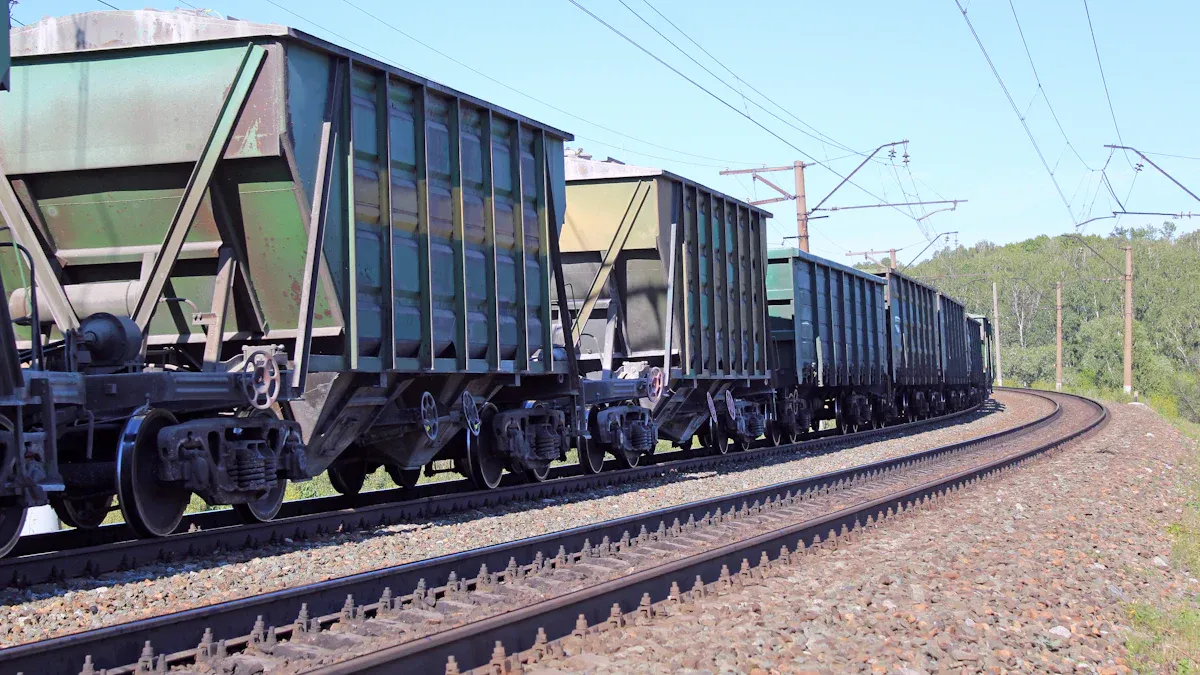What Is a Transportation Management System and How Does It Work

A transportation management system (TMS) is software that helps companies plan, carry out, and improve the movement of goods. This tool supports businesses by choosing the best routes, tracking shipments, and managing costs. Transportation Management Systems deliver clear benefits: on-time deliveries can improve by up to 50%, while fuel costs may drop 15%. Many industries see gains, such as reduced travel time, fewer errors, and better customer service. Companies also save time, with staff spending up to 25% less on manual tasks.
Key Takeaways
A Transportation Management System (TMS) is software that helps companies plan, track, and improve the shipping of goods, saving time and money.
TMS improves delivery by optimizing routes, automating tasks, and providing real-time shipment tracking to reduce delays and errors.
There are different types of TMS—on-premise, cloud-based, managed, and hybrid—each suited to different business sizes and needs.
Integrating TMS with other systems like warehouse and order management boosts supply chain visibility and speeds up decision-making.
Using a TMS leads to cost savings, better customer service, and higher efficiency by automating processes and improving communication.
What Is TMS
Definition
A transportation management system, often called TMS, is a type of software that helps companies move goods from one place to another. This system plans, carries out, and improves the shipping process. Many experts, including those at Oracle and Gartner, describe TMS as a tool that manages transportation activities, reduces freight costs, and improves service levels. Companies use TMS to compare shipping rates, book shipments, and track deliveries. The software connects with other systems, such as carrier management and data sources, to make planning and execution easier.
A TMS offers many features:
Route and load optimization to save time and money
Real-time shipment tracking for better visibility
Performance monitoring to track on-time delivery and carrier reliability
Integration with ERP and CRM systems for better customer updates
Research shows that about 35% of companies are adopting TMS platforms to control their transportation networks. Most large businesses and many small businesses already use these systems.
Purpose
The main purpose of Transportation Management Systems is to make shipping more efficient and cost-effective. These systems help companies deliver goods on time and in full, which keeps customers happy. TMS software gives real-time updates, so teams can track shipments and avoid delays. It also automates many manual tasks, which reduces errors and saves time.
Key goals of a TMS include:
Lowering transportation costs by finding the best routes and combining shipments
Improving communication between logistics teams and partners
Making sure companies follow rules and industry standards
Supporting sustainability by tracking emissions and helping reduce the carbon footprint
Transportation Management Systems also connect with other business tools, making it easier to manage the entire supply chain.
Types
There are several types of Transportation Management Systems. Each type fits different business needs and sizes. The main types include:
Type | Description | Best For |
|---|---|---|
On-Premise TMS | Installed on a company’s own servers. Offers full control and customization. | Large companies with IT support |
Cloud-Based TMS | Hosted online. Easy to access from anywhere. Updates happen automatically. | Small to medium businesses |
Managed TMS | A third party runs the system and handles daily operations. | Companies wanting less hands-on |
Hybrid TMS | Combines on-premise and cloud features. Flexible and scalable. | Growing businesses |
Tip: Companies should choose a TMS type based on their size, budget, and need for control or flexibility.
Transportation Management Systems continue to grow in popularity as more companies look for ways to improve their shipping and logistics.
How TMS Works

Main Processes
Transportation Management Systems help companies manage the movement of goods through several main processes. Each process plays a key role in making logistics more efficient and cost-effective. The table below shows how these processes impact logistics performance:
TMS Process Module | Impact on Logistics Performance | Supporting Details and Benefits |
|---|---|---|
Transportation Planning & Optimization | Cost savings, route optimization, load consolidation, carrier selection | Optimizes routes and cargo efficiency, reducing freight costs by 5-10%, improving margins and operational efficiency. |
Shipment Execution & Tracking | Real-time shipment visibility, improved on-time delivery | Enables efficient carrier scheduling and tracking, enhancing customer satisfaction and reducing delays. |
Documentation & Compliance | Automation of shipping documents, regulatory adherence | Digitization reduces trade documentation costs (bill of lading costs 10-30% of trade documentation), ensures accuracy and compliance. |
Customer Service & Collaboration | Enhanced customer satisfaction, stakeholder collaboration | Provides a unified platform for shipment tracking and communication among carriers, customs, and customers. |
Integration with WMS & OMS | Improved supply chain visibility and responsiveness | Synchronizes inventory and order data, enabling faster decision-making and agility in supply chain operations. |
SMB Challenges & TMS Solutions | Driver retention, asset management, procurement, visibility | Uses analytics to reduce driver attrition by 10-20%, automates maintenance, integrates eProcurement, and centralizes tracking. |
Transportation Management Systems improve logistics by automating and streamlining key steps like route planning, carrier selection, and freight billing. These systems use advanced algorithms and real-time data to optimize routes and reduce transportation costs. Companies benefit from fewer empty miles, fewer shipping delays, and better use of assets. This leads to lower costs and higher efficiency across the supply chain.
Note: TMS platforms also provide real-time shipment tracking and performance monitoring, which helps companies make quick decisions and adapt to changes.
Integrations
A strong Transportation Management System connects with other business tools to create a smooth flow of information. Integrations with order management systems (OMS), warehouse management systems (WMS), and enterprise resource planning (ERP) systems help companies build an end-to-end logistics strategy. These connections allow for better planning, faster response times, and improved accuracy.
A global retailer used a TMS and saw a 15% drop in freight spending. The system gave the company better visibility into routes, transit details, and carrier performance. It also allowed the company to track transportation costs down to each product. As a result, the retailer doubled its sales in one year while using fewer internal resources. This example shows how integrations can boost efficiency and data accuracy.
Integration with OMS, ERP, and WMS creates a complete logistics strategy.
AI and machine learning in TMS improve data accuracy and forecasting.
Automation of booking, billing, and payment reduces manual errors.
Real-time data and visibility help optimize routes and lower costs.
Technologies like EDI, API, and blockchain make data more secure and accurate.
Automation
Automation stands at the heart of modern Transportation Management Systems. By automating manual tasks, companies can save time, cut costs, and reduce errors. Research shows that automation in TMS brings many benefits:
Automation removes bottlenecks and errors, leading to faster turnaround and lower labor costs.
Optimized route planning saves fuel and reduces labor expenses.
Real-time tracking improves asset use and cuts idle time, lowering operational costs.
Load optimization combines cargo efficiently, reducing operating costs.
Automated invoice auditing finds and fixes billing errors, avoiding penalties.
Parcel and trucking companies use automation for routing, tracking, and scheduling. Electronic logging devices and automated scheduling make operations smoother. Full automation of trucks could cut operating costs by up to 45%. Automation also speeds up supply chain processes, reduces manual labor, and lowers costs from errors or delays. Better route planning saves fuel and delivery time, making the entire system more efficient.
Transportation Management Systems Features
Planning
Planning features help companies design the best routes and schedules for shipments. Route optimization tools use real-time data, such as traffic and weather, to adjust delivery plans. This saves time and fuel. Companies can use historical data and advanced mapping to choose the fastest and safest routes. Strategic planning also considers delivery windows and vehicle capacity. Automatic route optimization and dynamic rerouting help reduce delays and lower costs. These tools make operations more efficient and improve customer satisfaction.
Route planning and real-time tracking allow companies to adapt quickly to changes, reduce delivery delays, and improve efficiency. GPS and map integrations make these features easy to use.
Execution
Execution features manage the actual movement of goods. Shipment execution tools assign loads to carriers, schedule pickups, and handle dispatch. Fleet management tracks vehicles and drivers, while dock scheduling coordinates loading and unloading. Real-time shipment tracking and event notifications help companies respond to problems right away. Automated documentation ensures compliance and reduces errors. These features support proactive decisions, reduce disruptions, and improve on-time delivery rates.
Route optimization adjusts travel paths based on real-time data.
Automated order and dispatch management improves responsiveness.
Collaboration tools help shippers, carriers, and customers share information.
Tracking
Tracking features give companies visibility into every shipment. Real-time tracking uses GPS and IoT devices to monitor location and status. This helps identify and solve delivery issues quickly. Companies can see if shipments arrive on time, how long transit takes, and if any damage occurs. The table below shows key performance indicators for tracking:
KPI | Description |
|---|---|
On-time delivery rate | Percentage of shipments delivered within the agreed time window. |
Transit time | Average time for a shipment to travel from origin to destination. |
Transportation cost per unit shipped | Total transportation cost divided by units shipped. |
Freight damage rate | Percentage of shipments damaged or lost during transit. |
Payment
Payment features automate freight billing and financial processes. The system matches rates, loads, and delivery status before creating invoices. Integration with accounting tools streamlines reporting and reduces errors. Digital freight audits and shipment tracking verify carrier invoices against agreed rates. Automated auditing helps avoid overcharges and ensures payment only for completed services. These tools reduce disputes, speed up payments, and improve cash flow.
Automated freight bill auditing prevents mistakes and overcharging.
Analytics
Analytics features help companies make better decisions using data. Transportation Management Systems collect and analyze shipping data to find cost-saving opportunities and improve routes. Predictive analytics and machine learning uncover patterns and trends. Companies can track key metrics, such as delivery times and freight spending. Analytics also support safety by analyzing accident data and driver behavior. These insights help companies optimize operations, reduce costs, and improve service.
A leading manufacturer improved workflow efficiency and saved money by using transportation analytics to plan better routes and manage capacity.
Benefits of TMS

Cost Savings
Transportation Management Systems help companies save money in many ways. These systems reduce transportation and freight costs by 2% to 15%. Companies also see a 5% to 10% drop in warehouse labor costs and a 15% to 50% reduction in administrative labor costs. Automated freight audits lower billing mistakes and save 1% to 5% on freight expenses. The table below shows some of these savings:
Benefit Category | Documented Savings/Improvements |
|---|---|
Transportation and Freight Cost | 2% to 15% reduction |
Warehouse Labor Cost | 5% to 10% reduction |
Administrative Labor Cost | 15% to 50% reduction |
Freight Audit Cost | 1% to 5% reduction |
Companies also save money by using better routes, reducing empty miles, and improving carrier selection.
Efficiency
A TMS increases efficiency by automating manual tasks. Companies use these systems to speed up order fulfillment and reduce transit times. Automated order management, real-time tracking, and route planning help teams work faster and make fewer mistakes. Many companies report a 1% to 5% boost in operational efficiency. TMS also improves warehouse productivity and aligns dock schedules to avoid delays. 🚚
TMS automates planning, routing, and shipment tracking.
Integration with ERP and WMS improves data accuracy.
Visibility
Transportation Management Systems give companies real-time visibility into their supply chains. Real-time GPS tracking helps reduce theft and vehicle maintenance costs. Companies can track shipments, monitor inventory, and see delivery status at any time. Studies show that 70% of organizations rank real-time supply chain visibility as a top goal. Full visibility can reduce unmet customer demand by up to 7%. By 2024, half of supply chain organizations will invest in AI-powered tools to improve visibility and decision-making.
Customer Service
A TMS improves customer service by making deliveries more reliable and accurate. On-time delivery rates can reach up to 95%. Order accuracy increases, which builds customer trust. The table below highlights key customer service metrics:
Metric | Description | Impact on Customer Service |
|---|---|---|
On-time Delivery Rate | Shipments delivered by promised date | Higher satisfaction |
Order Accuracy | Orders fulfilled correctly | Fewer errors, more trust |
Customer Satisfaction | Survey or NPS-based score | Better service, happier customers |
Clean, reliable data from a TMS helps companies make better decisions and respond quickly to customer needs.
Users and Selection
Who Uses TMS
Many types of businesses use Transportation Management Systems. Manufacturers, retailers, wholesalers, and logistics providers rely on TMS to move goods efficiently. Large companies with high shipment volumes often need advanced features, but small and medium-sized businesses also benefit from cloud-based or managed TMS options. Industries such as food and beverage, automotive, healthcare, and consumer goods use TMS to improve delivery times and reduce costs. Third-party logistics (3PL) providers use TMS to manage shipments for multiple clients. Companies that ship products across long distances or need to track many deliveries find TMS especially valuable.
Note: Companies in fast-moving industries, like e-commerce, depend on TMS for real-time tracking and quick response to customer needs.
Choosing a TMS
Selecting the right TMS involves matching business needs with system capabilities. Companies should look at shipment volume, integration with existing systems, and the ability to handle complex logistics. Important criteria include:
Alignment of shipment volume with TMS capacity
Key performance indicators (KPIs) such as on-time delivery rates and cost per shipment
Cost savings and return on investment (ROI) from reduced fuel use and better load planning
Carrier performance data to choose reliable partners
Strong reporting and analytics tools for data-driven decisions
Integration with ERP and warehouse management systems
Many businesses use structured methods like the Analytic Hierarchy Process (AHP) to compare both numbers and opinions when choosing a TMS. This approach helps companies make clear, confident decisions.
Best Practices
Successful TMS implementation follows proven steps. Companies should:
Review and clean existing data to ensure accuracy.
Collect reliable data on costs, such as labor and equipment.
Validate models with historical data and expert input.
Set clear goals and track KPIs like on-time performance.
Train users and provide ongoing support.
Start with a pilot project before full rollout.
Monitor results with dashboards and cost reports.
Build strong relationships with carriers to address driver shortages and improve service.
A large consumer goods manufacturer improved delivery times and reduced costs by using TMS for route optimization and carrier selection. Real-time visibility and better planning led to higher customer satisfaction and profitability.
Transportation Management Systems transform logistics by optimizing routes, reducing costs, and improving efficiency. Companies gain real-time tracking, predictive analytics, and centralized control, which support better decision-making.
TMS adoption continues to rise as businesses seek to lower logistics expenses, which often make up 10% of total costs.
Advanced features like AI and IoT help companies manage risks and improve shipment accuracy.
Businesses should assess their needs, compare solutions, and prioritize systems that offer strong integration and data-driven insights.
FAQ
What types of companies benefit most from a TMS?
Manufacturers, retailers, wholesalers, and logistics providers gain the most from a TMS. These companies often ship large volumes or need to track many deliveries. A TMS helps them save money, improve delivery times, and increase customer satisfaction.
Can a small business use a TMS?
Yes. Many cloud-based TMS solutions work well for small businesses. These systems offer easy setup, lower costs, and simple features. Small companies can use a TMS to plan routes, track shipments, and manage costs.
How does a TMS improve delivery accuracy?
A TMS uses real-time tracking and automated alerts. These features help companies monitor shipments and fix problems quickly. Accurate delivery data reduces mistakes and ensures goods arrive on time.
Is it hard to integrate a TMS with other systems?
Most modern TMS platforms offer easy integration with ERP, WMS, and order management systems. Companies can connect their TMS using APIs or EDI. This creates a smooth flow of information across the supply chain.
What is the main difference between cloud-based and on-premise TMS?
Cloud-based TMS runs online and updates automatically. Users can access it from anywhere. On-premise TMS installs on company servers and offers more control. Each type fits different business needs and budgets.
See Also
Affordable Transportation Solutions That Fit Within Your Budget
Analyzing JUSDA's Adoption Of Advanced Logistics Technology
Discovering Cutting-Edge Transport Tech Transforming Supply Chains
How JUSDA's Logistics Technology Boosts Operational Efficiency
Comprehensive Insights Into Eco-Friendly Supply Chain Transport
